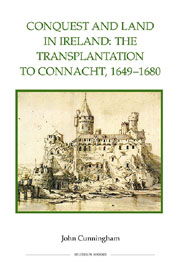Book contents
- Frontmatter
- Contents
- List of maps
- Acknowledgements
- Abbreviations
- Introduction
- 1 Conquest and land in Cromwellian Ireland, 1649–1652
- 2 Towards plantation and transportation, 1652–1654
- 3 The land settlement under threat, 1653–1655
- 4 Enforcing transplantation, 1655–1659
- 5 Transplantation in County Roscommon
- 6 The transplanters and the Restoration land settlement
- Conclusion
- Bibliography
- Index
5 - Transplantation in County Roscommon
Published online by Cambridge University Press: 05 February 2013
- Frontmatter
- Contents
- List of maps
- Acknowledgements
- Abbreviations
- Introduction
- 1 Conquest and land in Cromwellian Ireland, 1649–1652
- 2 Towards plantation and transportation, 1652–1654
- 3 The land settlement under threat, 1653–1655
- 4 Enforcing transplantation, 1655–1659
- 5 Transplantation in County Roscommon
- 6 The transplanters and the Restoration land settlement
- Conclusion
- Bibliography
- Index
Summary
The redistribution of land under schemes of plantation and transplantation was to be the main legacy of the Cromwellian period in Ireland. These processes entailed a drastic reduction in Catholic proprietorship, from around 61 per cent of the land of Ireland in 1641 to less than 10 per cent by the end of the 1650s. These figures provide a stark indication of the extent to which Irish landed society was transformed. In order to comprehend the practical consequences of this revolution at the local and familial level, it is necessary to select and zoom in on one section of the map of Cromwellian Ireland. This chapter will explore how the transplantation scheme impacted on landownership patterns in Co. Roscommon. The process of land redistribution in question can be broken down into four parts. First, it is necessary to establish how much land was reserved around towns and garrisons and in the proposed cordon sanitaire along the river Shannon intended to insulate Protestant Ireland from Catholic Connacht. The transplanters themselves can be arranged for the purposes of analysis into two groups: the local existing landowners; and the incomers from other counties. Many transplanters quickly sold their assignments of land to another group which would subsequently become known as the Connacht Protestant purchasers. This unplanned aspect of the transplantation played a key role in reconstituting the profile of landholding in Connacht up to 1660.
- Type
- Chapter
- Information
- Conquest and Land in IrelandThe Transplantation to Connacht, 1649-1680, pp. 100 - 118Publisher: Boydell & BrewerPrint publication year: 2011



